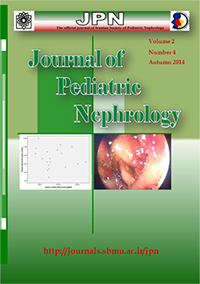Introduction: Deficiencies of water soluble vitamins such as folate and vitamin B12 has been reported as etiologic factors of hyperhomocysteinemia. This study was conducted to find whether there is a correlation between serum levels of these vitamins and plasma total homocysteine (tHcy) levels.
Material and Methods: 19 hemodialysis subjects were enrolled. The study group comprised 52.6% girls and 47.4% boys aged 80-324 (204.7±78.4) months who were on dialysis from 1.5-153 (42.1±43.3) months ago. All patients were supplemented by folate and 15 cases were received oral vitamin B12.Folate serum levels <1.5 ng/ml were defined as low (deficiency).As for vitamin B12, levels < 120 pg/ml, 120-160 pg/ml were defined as deficient and borderline, respectively. Plasma Hcy levels of 5-15 µmol/L and > 15 µmol/L were defined as normal and hyperhomocysteinemia, respectively. The correlation between the serum levels of vitamins and plasma Hcy levels was checked by the Pearson correlation test and P-values <0.05 and r>0.7 indicated a good (significant) correlation.
Results: 13 patients (68.4%) had hyperhomocysteinemia whereas plasma tHcy levels were normal in 6 (31.6%). No patient had folate or vitamin B12 deficiency.There was no correlation between tHcy levels and serum vitamin B12 (P=0.621, r=1) and serum folate levels (P=0.571, r=1).
Conclusions: Normal and even high serum levels of folate and vitamin B12 cannot prevent the occurrence of hyperhomocysteinemia in hemodialysis patients.
Keywords: Hemodialysis; Folate; Vitamin B12; Homocysteine; Hyperhomocysteinemia.

